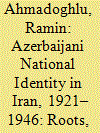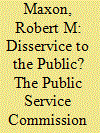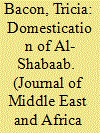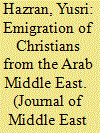|
|
|
Sort Order |
|
|
|
Items / Page
|
|
|
|
|
|
|
| Srl | Item |
| 1 |
ID:
168854


|
|
|
|
|
| Summary/Abstract |
This article examines the roots and development of Azerbaijani identity in Iran. This study aims to demonstrate that the Azerbaijani minority in Iran lacked consciousness of a distinct national identity at the dawn of the twentieth century, and argues that the driving force behind the emergence of the consciousness of Azerbaijani national identity in Iran was the Pahlavi regime’s repressive and exclusivist nationalist policies between 1921 and 1941. Building upon the grievances of the Pahlavi era, the occupation of Iran by Allied forces during the Second World War and the short, Soviet-supported autonomy under the leadership of Sayyed Ja’far Pishevari in 1945–1946 institutionalized and consolidated the Azerbaijani Turkish identity in Iran.
|
|
|
|
|
|
|
|
|
|
|
|
|
|
|
|
| 2 |
ID:
168853


|
|
|
|
|
| Summary/Abstract |
The need to create an efficient, nonpartisan public service that would reflect the population of African colonies approaching independence rather than the colonial rulers and meet the needs and aspirations of those people was one of several critical issues to emerge in the late 1950s. The article focuses on the issue in Kenya. The decolonization process created a need for change in the composition of the public service brought forth competing views as to the best way to achieve an inclusive and efficient civil service, particularly with regard to its structure. This became a subject of contention during the constitutional conferences held during the period 1960–1963 to plot the constitutional path to independence for the British colony. The nationalist political parties put forward contrasting visions for the public service in independent Kenya. The article details this as well as the attitude of the colonial power as Kenya sought the best way to establish a civil service that would provide service to the public from qualified individuals representing Kenya’s diverse population. While the self-government constitution (June 1, 1963) provided for eight public service commissions, this was drastically changed to a single public service commission in the independence constitution (December 12, 1963). The alteration was insisted upon by independent Kenya’s first government, but it came to be viewed as a disservice to the public through failure to produce a nonpartisan and inclusive public service.
|
|
|
|
|
|
|
|
|
|
|
|
|
|
|
|
| 3 |
ID:
168855


|
|
|
|
|
| Summary/Abstract |
How much influence did foreign fighters exert over al-Shabaab’s insurgency in Somalia? An emerging policy consensus is that foreign fighters exert decisive influence on insurgencies, even affecting conflict duration, intensity, and outcomes. Nevertheless this study argues that foreign combatants in Somalia have exerted a more limited influence than this consensus suggests, though this influence has varied over time. Foreign fighters were present within al-Shabaab from its inception, and remain a part of the group over ten years later. Over this period, non-Somali combatants enjoyed the most influence during the insurgency against Ethiopian forces between 2007 and 2008, when al-Shabaab was a young organization facing a superior enemy. Over time, foreign fighters’ influence within the insurgency in Somalia diminished as al-Shabaab became “domesticated,” i.e. gained controlled of territory and began to govern. This study examines four periods in recent Somali history: the Islamic Court Union’s rise pre-2006, the Ethiopian invasion from 2007 to 2008, al-Shabaab’s territorial conquests from 2009 to 2010, and the internal divisions and purge from 2011 to 2013. This article concludes with a word of caution on the growing perceptions that foreign fighters shape insurgencies and that their involvement significantly helps or hurts local opposition movements. In the case of al-Shabaab’s insurgency in Somalia, transnational insurgents shaped external actors’ calculus in ways that have affected the conflict’s duration, intensity, and even outcomes, but they did not have a commensurate impact within the insurgency.
|
|
|
|
|
|
|
|
|
|
|
|
|
|
|
|
| 4 |
ID:
168851


|
|
|
|
|
| Summary/Abstract |
Since the late 1950s, Christians’ emigration from the Arab Middle East has been a basic phenomenon affecting the political and social landscape of the region as well as a fundamental dynamic behind the depression of its Christian demography. This article shows that the intensive departure has been the result of structural and historical factors related to the performance of the modern Arab nation-states in the post-colonial era. Instead of the generalized and simplistic explanations that are often advanced that link the Christians’ emigration to Islamic revivals, the main dynamic of this out migration instead can be found in the policies of the modern Arab state and the outbreak of communal and regional conflicts.
|
|
|
|
|
|
|
|
|
|
|
|
|
|
|
|
| 5 |
ID:
168852


|
|
|
|
|
| Summary/Abstract |
In modern-day South Africa, both the state and the wider society assume that people whose mother tongue is Zulu are Zulus. How can we explain this close relationship between language and ethnic identity? This essay rejects the primordialist answer, which holds that language and ethnic identity are naturally occurring as well as naturally related phenomena. Instead, it argues that a language-based Zulu identity emerged due to a complex historical process involving human decision-making about what constitutes the Zulu language and who speaks it. A series of stakeholders, notably American missionaries, created the standard, literary Zulu language between 1835 and 1930. At the same time, these stakeholders designed institutions and practices that socialized generations of people to the idea that this standard, literary Zulu language represented their mother tongue. The most important institutions were mission and state-led primary education programs in which standard, literary Zulu functioned as a mandatory language subject between the 1850s and the 1990s. As a language-based ethnic identity, Zuluness is, thus, the product of a historical process that involved language standardization and language education. It is a modern identity that is essentially different from its precolonial antecedents.
|
|
|
|
|
|
|
|
|
|
|
|
|
|
|
|
|
|
|
|
|